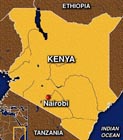Football stadium tragedies all too common in Africa
 Nairobi - Sunday should have been a day of celebration for the tens of thousands of Ivorians who flocked to the Houphouet-Boigny stadium in Abidjan to see their hero, Chelsea's Didier Drogba, score twice in Ivory Coast's 5-0 route of Malawi in a World Cup qualifier.
Nairobi - Sunday should have been a day of celebration for the tens of thousands of Ivorians who flocked to the Houphouet-Boigny stadium in Abidjan to see their hero, Chelsea's Didier Drogba, score twice in Ivory Coast's 5-0 route of Malawi in a World Cup qualifier.
Yet before the game had even begun, 22 football fans were dead and over 100 injured in a crush that came after a wall collapsed beneath a mass of bodies - a disaster all the more tragic for its commonality in the African game.
According to the government, the stampede came as ticketless fans tried to rush the gates to enter the 45,000-capacity stadium.
"The supporters came in huge numbers... there were more outside than inside the stadium," said Interior Minister Tagro Desire. "The match was about to begin and everyone wanted to enter."
Witnesses, however, told local media a different story.
They said that police and gate officials took bribes to allow entry to people without tickets, that too few gates were open, and that a barrage of tear gas fired by police caused the stampede.
Football's ruling body FIFA said Monday it had demanded a report from Ivorian Football Federation, adding it would continue its efforts "to ensure that such tragic circumstances do not happen again."
Unfortunately, the disaster was by no means an isolated incident in Africa.
In 2001, some 127 people during a stampede at a local game in Accra, Ghana and 43 were killed at Ellis Park, South Africa, as thousands tried to push in to a league match. Dozens also died at games in Zimbabwe and the Democratic Republic of Congo in the same year.
The problem then seemed to abate until last year: The Ivory Coast stampede is the third deadly incident at an African ground in the last nine months.
Some 23 people died in Sudan at a game in July and another 13 in DR Congo in September after riots broke out following accusations of witchcraft.
The deadly cocktail of factors that can lead to tragedy are all too apparent at most big games in Africa.
The number of fans attempting to enter the stadium often dramatically exceeds the capacity. Supporters, however, seem unmindful of the danger.
They scale fences, clamber up floodlight towers, squeeze under gates and rely on sheer force of numbers to break down barriers.
The police oscillate between indifference - they are frequently too busy watching the game - to firing tear gas into the masses at the slightest provocation.
The stadium infrastructure is usually less than ideal. Fans are forced to queue for hours to squeeze through a few narrow turnstiles.
Once the game begins, the gates are often locked, meaning that a rush to escape crowd trouble can lead to crushes - as was the case in Ghana.
With such problems commonplace, African football has arguably been lucky not to experience a Ghana-style disaster in recent years. But the tipping point is never far away.
Kenya came close to its own disaster at a World Cup qualifying match with Guinea at Nairobi's Nyayo stadium last June.
Thousands of fans forced open a gate and poured into the stadium, which was filled to capacity. The police exacerbated the problem by forcing people trying to climb fences to escape the crush back into the mass of bodies.
The crowd eventually dissipated onto the grassy verge separating the terraces from the pitch, but it could so easily have turned into disaster.
With the 2010 World Cup being held in South Africa, the disorder on the rest of the continent could be a cause for concern.
However, Danny Jordaan, head of South Africa's World Cup committee, said Monday he expects no problems.
According to Jordaan, most crushes are caused by fans turning up to buy tickets at the last minute.
In South Africa, all ticket sales will be held in advance and ticketless fans will be stopped several kilometers away from the stadiums.
A test game on Saturday between South Africa and Norway showed that security may even be too tight.
The Royal Bafokeng Stadium in Rustenburg, North-West province, was half-full for much of the game - despite being sold out - as fans waited at the security barriers two kilometres away.
But the security in 2010, with the eyes of the world on South Africa, will be a far cry from the average in the rest of Africa.
In Europe, tragedies such as the 1985 Heysel disaster, when 39 fans were crushed during rioting, and the 1989 Hillsborough stampede, in which 96 fans died, helped prompt drastic changes to stadium safety.
But in Africa, footballing authorities and governments - whether through a lack of money or a lack of will - are not taking the necessary precautions. The next disaster may only be a matter of time. (dpa)